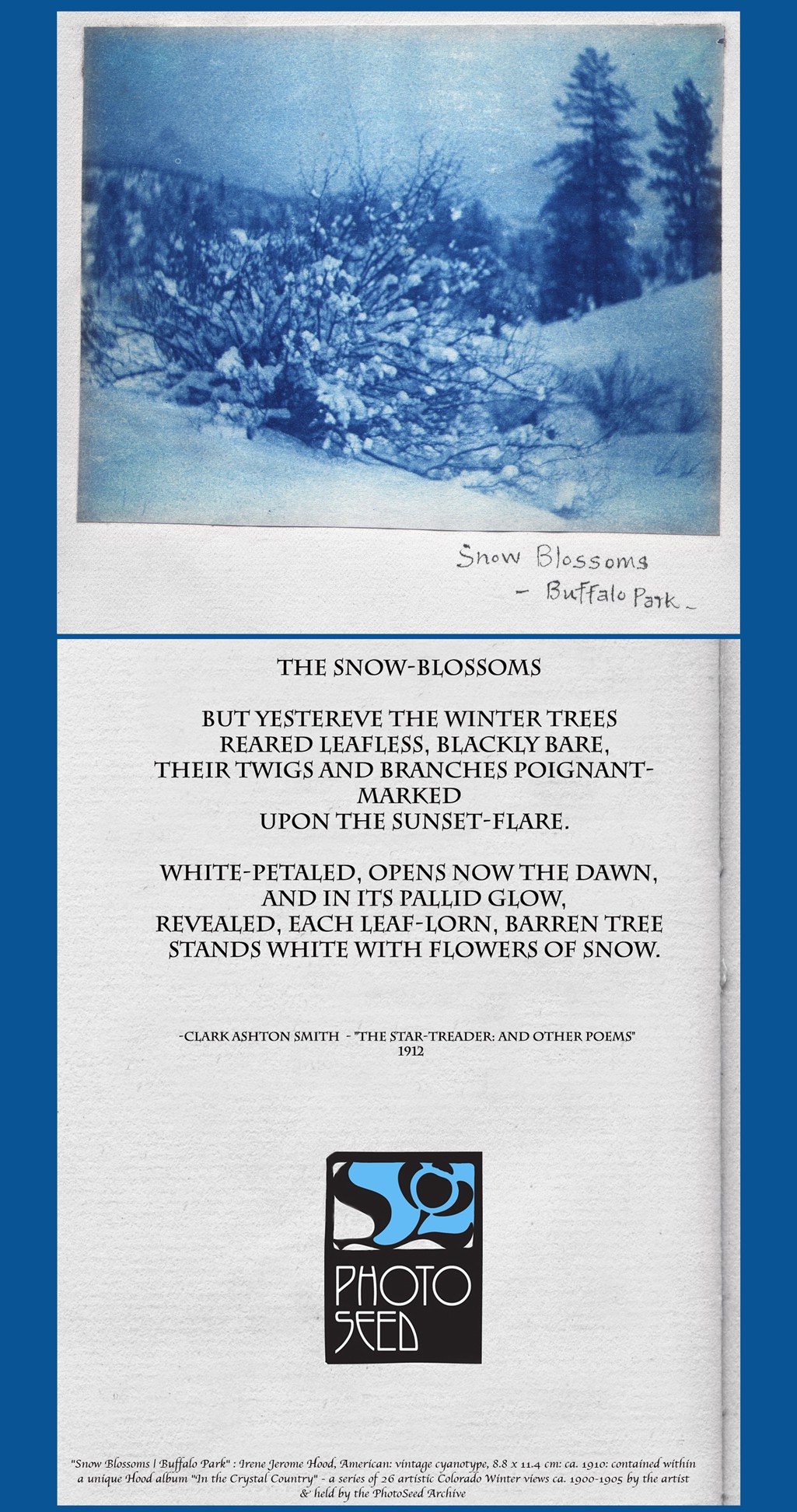

Like others around the world, our hearts are broken for the beautiful citizens of Ukraine. Their determination in the present war is just, and it is our belief their future will reaffirm what is rightly theirs: a democratic country they can always call home; a place where living in peace and harmony with neighbors is a given; and one where their children will always be safe in knowing the love of parents and dreams of listening to a just future are always close by and achievable.
Please consider a donation to the Save the Children Ukraine Crisis Relief Fund.
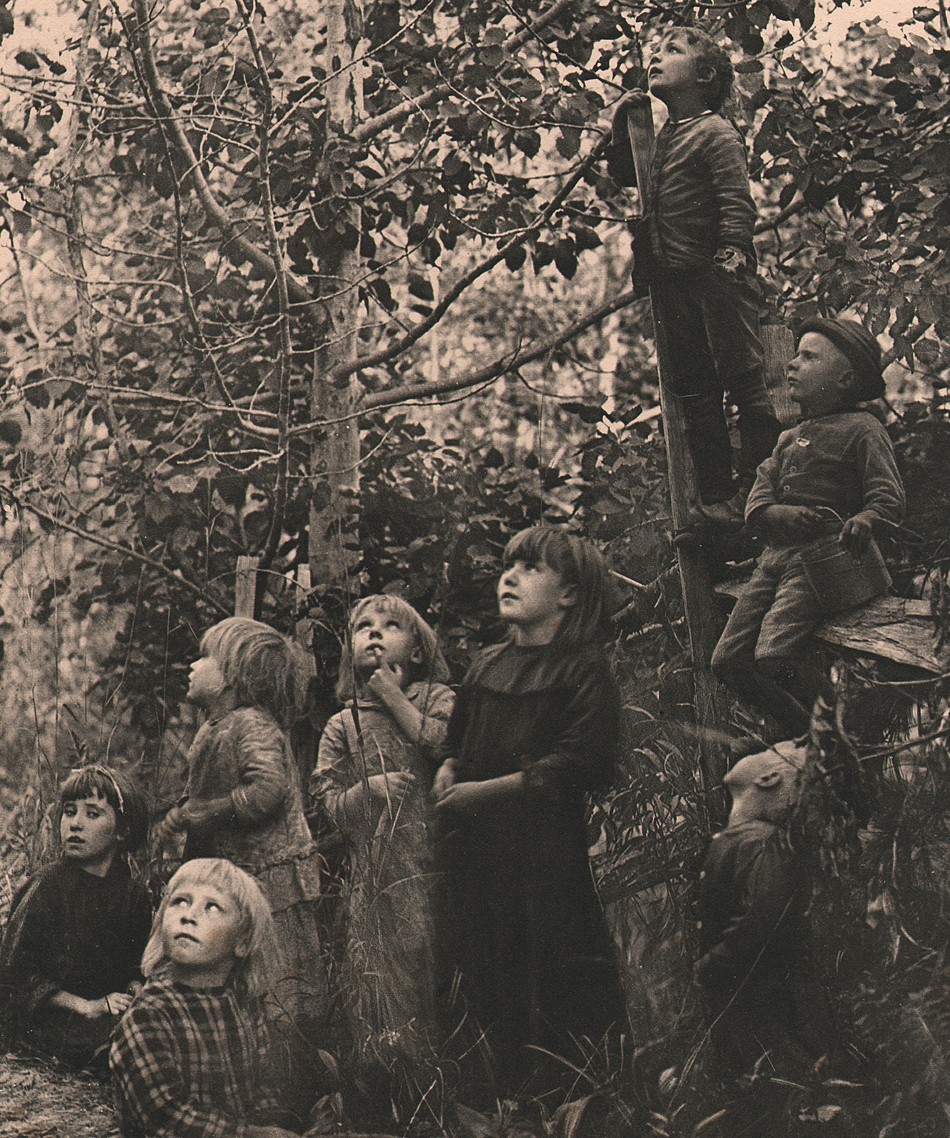
Detail: “Listening to the Birds”. John E. Dumont, American (1856-1944) 1892 signed print (Copyright 1885) : Photogravure: Chine-collé: 33.5 x 25.1 | 40.7 x 34.0 cm. This fine genre study by Dumont of eight children shows them gathered outdoors near a fence and gazing skyward while listening and gazing at birds nesting or flying overhead. The photograph went on to win multiple prizes and medals, including a prize at the prestigious and groundbreaking 1891 Vienna Salon, the first international exhibition where photographs were accepted and judged solely on artistic merit. From: PhotoSeed Archive
Sending you a bit of Love on this Saint Valentines Day.
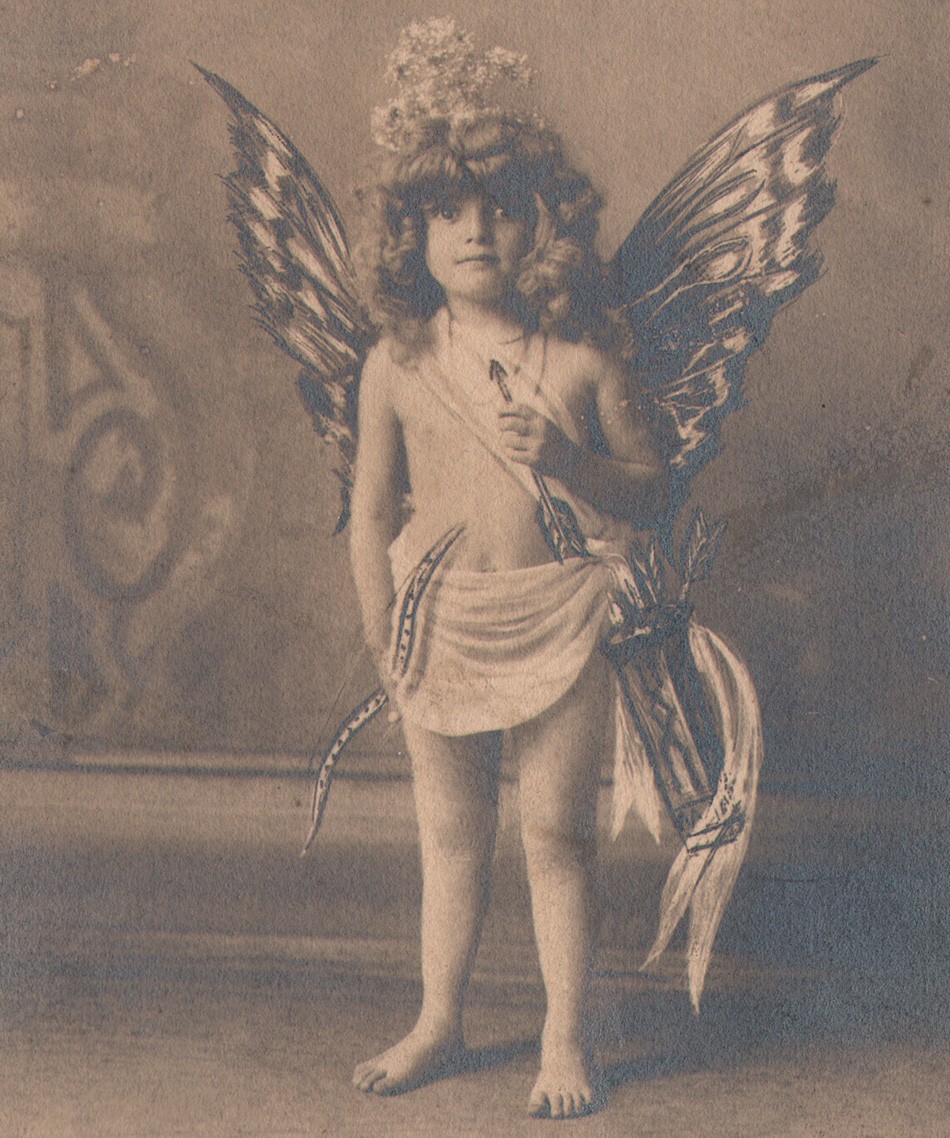
Detail: “Cupid”: Walter-Mitchell Studio: (Floyd A. Walter & William R. Mitchell- American) (28 E. 14th St. New York) cabinet card with pasted gelatin silver print, ca. 1910. 13.9 x 9.9 | 20.0 x 14.7 cm. With stretched “wings” and sporting a “quiver”, this unknown child model Cupid holds an “arrow” while standing before a painted studio backdrop. The wings, arrow and quiver are all hand-drawn in this vintage combination print taken at the Walter-Mitchell Studio, then located in the Joseph J. Little Building on 28 East 14th Street in New York City, still standing today. Built in 1881, this important “cast-iron building drew tenants who were artists and manufacturers, drawn by the ample light provided by the unusually large north-facing windows overlooking Union Square.” (Village Preservation online resource) From: PhotoSeed Archive
A reappraisal of old photos has recently invaded the public conversation of late. Artificial intelligence, in the form of video driver technology invented by Israeli company D-ID, was licensed earlier this year to genealogy and DNA company MyHeritage with the moniker Deep Nostalgia™. Old photographs, no matter their original medium, are brought to life as short animated video clips, and may never be seen in the same way again.
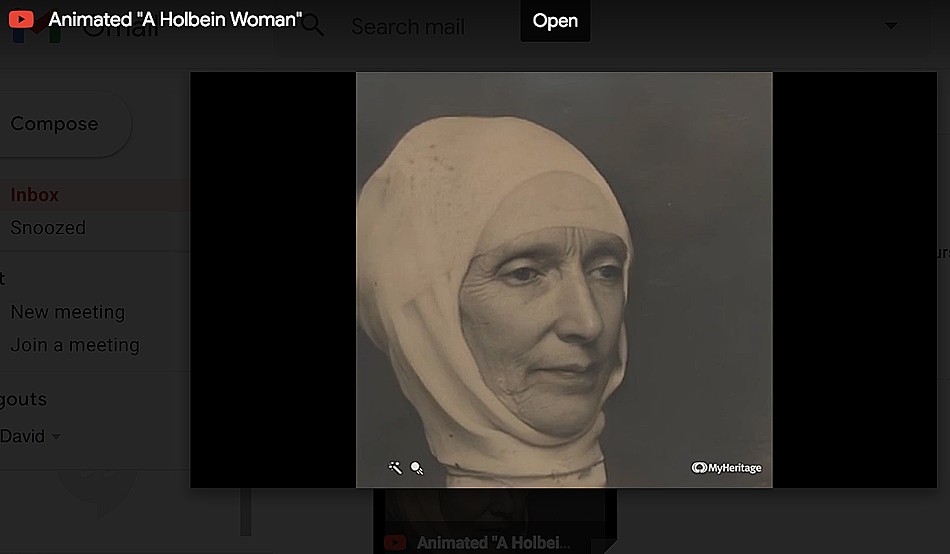
Screenshot: Animated “A Holbein Woman” from YouTube. Cropped image of same by American photographers Frances Stebbins & Mary Electa Allen, ca. 1890 using the Deep Nostalgia™ app licensed to genealogy and DNA company MyHeritage. Original source photograph from PhotoSeed Archive.
Taking up the company’s free offer to try out the technology, I applied it to a recent archive acquisition, A Holbein Woman, taken in the very early 1890’s by Deerfield, Massachusetts sister photographers Frances Stebbins and Mary Electa Allen. You can see the result in a short 12 second video posted to YouTube embedded above in this post.
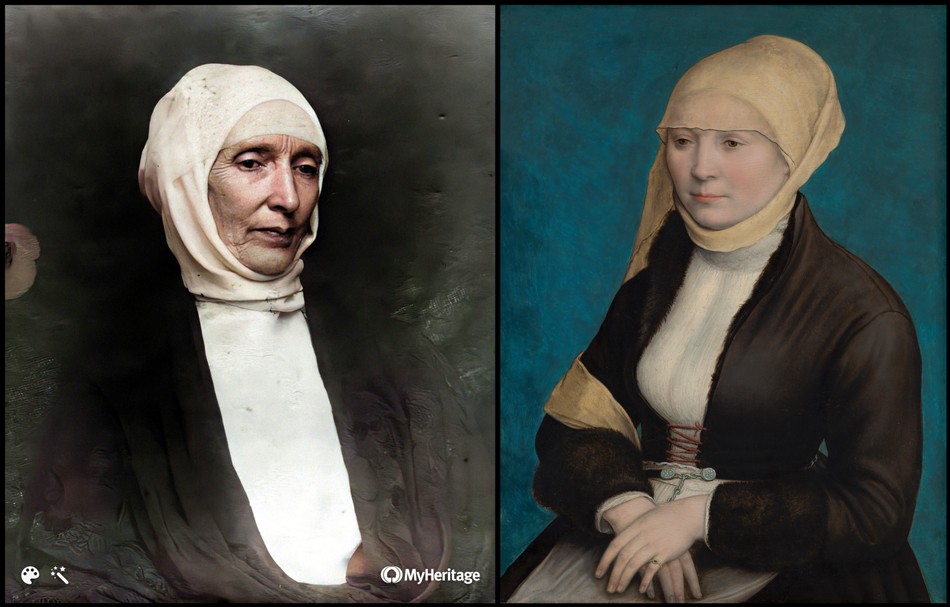
Left: Colorized version of “A Holbein Woman” by American photographers Frances & Mary Electa Allen, ca. 1890. Created by DeOldify deep learning experts Jason Antic and Dana Kelley, this colorizing technology has been licensed from DeOldify by DNA company MyHeritage, with their branding of MyHeritage In Color™. Source photograph from PhotoSeed Archive. Right: “Portrait of a Woman from Southern Germany”: c. 1520-25: Formerly attributed to Hans Holbein the Younger, Germany: (1497/1498-1543): Oil on panel: 45 x 34 cm: Courtesy: collection of the Mauritshuis museum in The Hague.
The photograph, considered a masterwork of early genre pictorialist portrait photography, is of their mother Mary Stebbins Allen, (1819-1903) and in itself done after the then fashionable practice (1.) of an imitation painting: in this case, a Renaissance portrait by Bavarian artist Hans Holbein the Elder. (c. 1460-1524) To add another layer of mystery, research I did last year revealed the primary source portrait- the oil painting (c.1520-1525) known as “Portrait of a Woman from Southern Germany” in the collection of the Mauritshuis museum in The Hague, was originally attributed to Holbein’s son “The Younger”, (c. 1497-1543) with the now updated disclaimer by the museum’s curators as being “formerly attributed” to this artist. This painting can be seen at upper right, with a colorized version of the Allen sisters portrait run through remarkable colorization technology MyHeritage In Color™ at left.
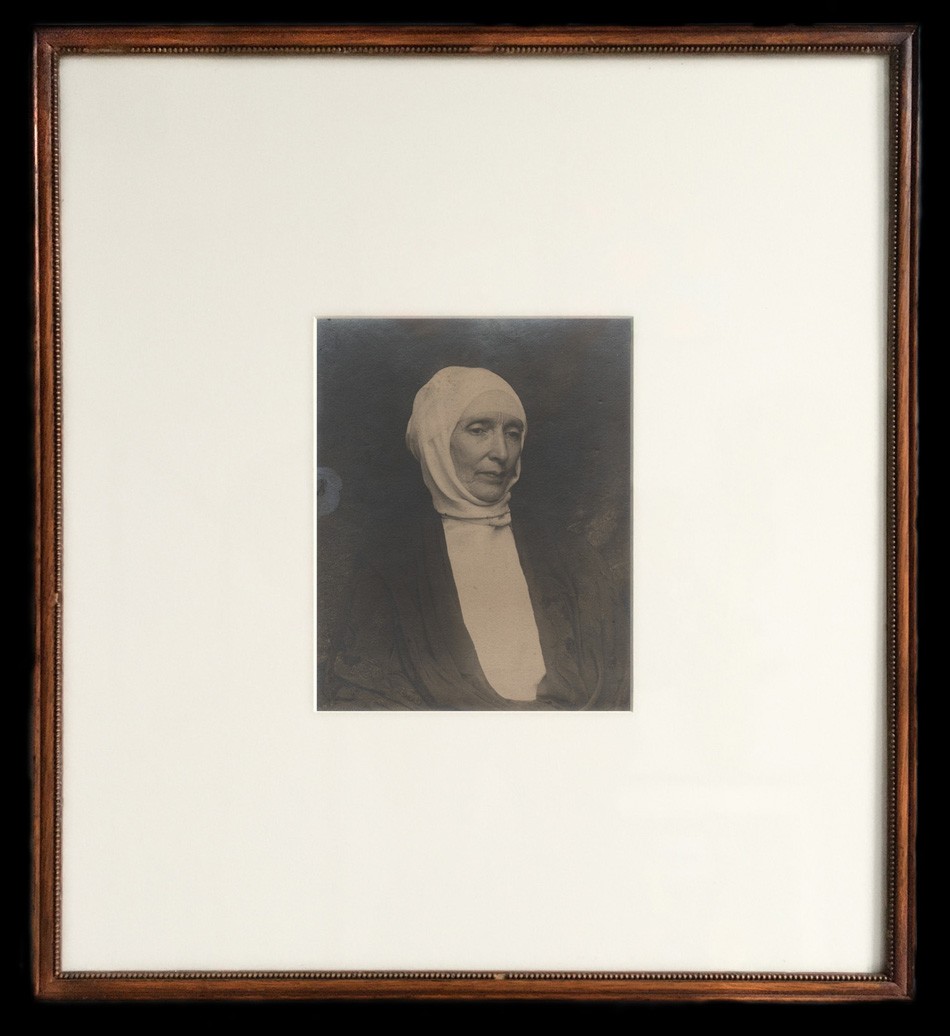
“A Holbein Woman”: Frances Stebbins & Mary Electa Allen, American: 1854-1941 & 1858–1941. Gelatin silver print ca. 1890: 20.1 x 16.3 cm laid down on light gray card mount 35.2 x 27.8 cm: presented here in original ca. 1896 beaded wood frame by Greenfield, MA framer Dunklee & Freeman with original overmat replaced. Done with the intent of being a tribute imitation painting to Hans Holbein’s “Portrait of a Woman from Southern Germany”, the subject of this portrait is the photographer’s mother Mary Stebbins Allen. (1819-1903) The result: “A Holbein Woman”, was one of the earliest and most successful examples of portraiture done by the Deerfield, MA sisters. From: PhotoSeed Archive.
Another words, if being accurate to revisionist history but without the convenient addition of a famous name, (2.) the Allen sisters efforts in the modern day might conceivably be retitled “A Formerly Attributed Woman” rather than “A Holbein Woman”.
And although it is but one example reanimated from that era using new technology, it seems reasonable to conclude 21st Century progress courtesy of Deep Nostalgia™ may only reinforce and belie a continuation of certain prejudices and expectations from the past, the same criticism that could be leveled at video driver technology being only an approximation of humanity, leaving us devoid of the true mannerisms of those who actually lived.
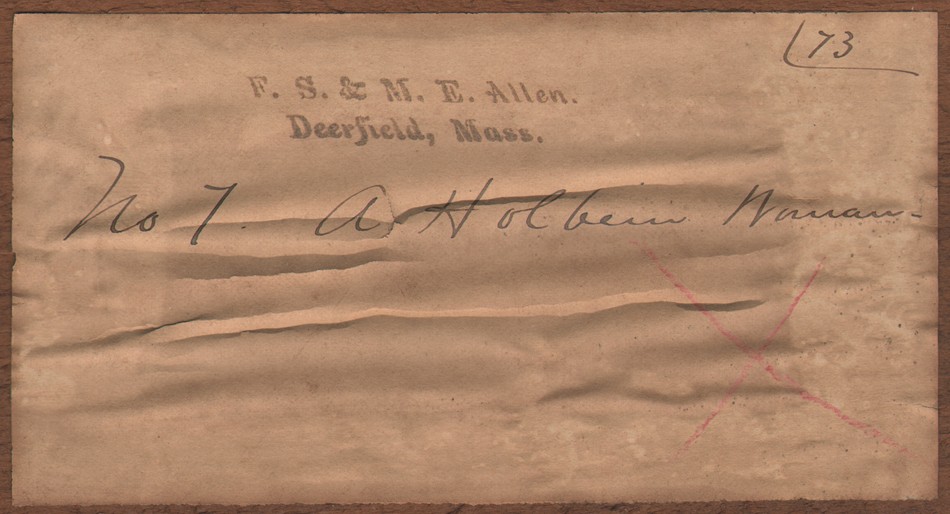
Exhibition label: “A Holbein Woman”: ca. 1896. Pasted white-paper label (7.2 x 13.6 cm) (preserved and cut out from) wood backing board with black ink photographers stamp: F.S. & M.E. Allen. Deerfield, Mass.; in black ink believed to be in the hand of the photographers: No 7 A Holbein Woman: 73 to upper right corner, faint X mark in red ink in lower right. From: PhotoSeed Archive
“Creepy” is one online descriptor I kept encountering in people’s reactions to this new technology, but when has that ever stopped “progress”? (3.) Are we doomed or can fleeting perceptions of the past in old photographs brought to “life” change our future for the better, our marveling reactions to it as incidental as the new shiny object of the here and now? Only time will tell. (4.) David Spencer-
Notes:
1. The worldwide pandemic brought on by COVID-19 lockdowns inspired a massive revival of imitation paintings and other works of art including photography. Amsterdam’s Rijksmuseum in March, 2020 promoted their Stay at Home Challenge!, inviting people to recreate modern day reinterpretations from masterworks in their collection. This was soon followed by the Getty museum in California. One of the very first “challenge” accounts to promote this revived genre was the Netherlands Instagram account Tussen Kunst & Quarantaine– translating to “between art and quarantine” which first inspired the Rijksmuseum challenge.
2. This would never happen.
3. An examination of ethical concerns as a result of so-called Deepfake technology contained within Deep Nostalgia™ is explored in a New York Times article written by Daniel Victor from March 10, 2021: Your Loved Ones, and Eerie Tom Cruise Videos, Reanimate Unease With Deepfakes.
4. That shiny object has been here since February, 2021. Care to upload a selfie, historical photograph or stock pic of Kim Jong-un, Mao Zedong or Joe Biden and see yourself or them “sing” to popular music? Then download the WOMBO app here. Guardian technology columnist Helen Sullivan reports on March 12, 2021 the app just might be giving competition to Deep Nostalgia™.
At PhotoSeed, we celebrate the life of Ann McElroy Spencer, 1929-2021, one of our most profound influences.
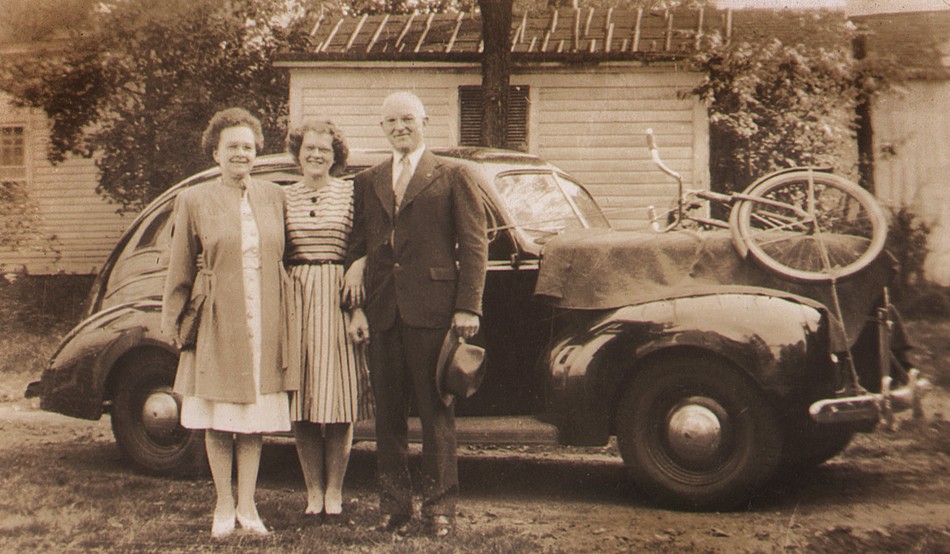
Detail: “Day Ann left for College, Sept. 1946” Jane Ross, American: gelatin silver print: 1946: 9.0 x 15.0 cm. At center, the author’s mother, Ann McElroy, 17, is shown outside her home on South Main Street in Orange, MA flanked by parents James Ernest McElroy (1900-1961) and Edna Sawyer Blanchard (1901-1961). My mom’s bicycle (the color was red) can be seen strapped to the hood of the family car, ready to take her on new adventures and freshman year at the University of Massachusetts at Amherst. Growing up in Orange, my mom was fortunate to have the life-long love of a little sister, my Aunt Jane, and her parents, who were both active and civically engaged in their small New England town. Edna was known by everyone there by her nickname “Happy,” and my grandfather James, recently discharged as a Lieutenant, who served in the United States Navy Reserve in WWII, was the town’s assistant postmaster. Tragically, their lives were cut short in an automobile accident, an event that impacted and shaped the young lives of my mother and aunt. From: Authors family archive.
Words often fail at times like these, but I wanted to take a few moments to recount one remembrance in the very rich life of my mother, Ann McElroy Spencer, 1929-2021, who passed last week. And it has a photography angle! On a late spring day about 20 years ago, I discovered the true secret of her selfless character, qualities reaffirmed to me in her final years by her fellow residents at the assisted living facility she called home.

Detail: “Portrait of Ann McElroy Spencer”: Sieglanide “Sissi” Shattuck, American, born Austria: oil on canvas: 1962: 38” x 30” Artist Sissi Shattuck of New Hampshire was a friend of my mother and father in the late 1950s and 1960s. This portrait of my mom, done in her early 30s, always inspired me and it hung for years in the living room of our Connecticut home- the author of this post also had the great fortune to sit for the artist in 1969. From: family collection (artwork © by SissiStudio: sissistudio.com)
On that day, she suggested we take a walk around my old neighborhood, where I had grown up but had long since departed for a career in newspaper photojournalism and, in my mind, greener pastures. To my surprise, the walk this day took us up a long steep hill, a bit distant from the route I was expecting. After reaching the summit and turning left, I was hesitant about where the journey would ultimately lead, but she seemed intent, and I did not question, happy to be sharing some good one-on-one time with her.
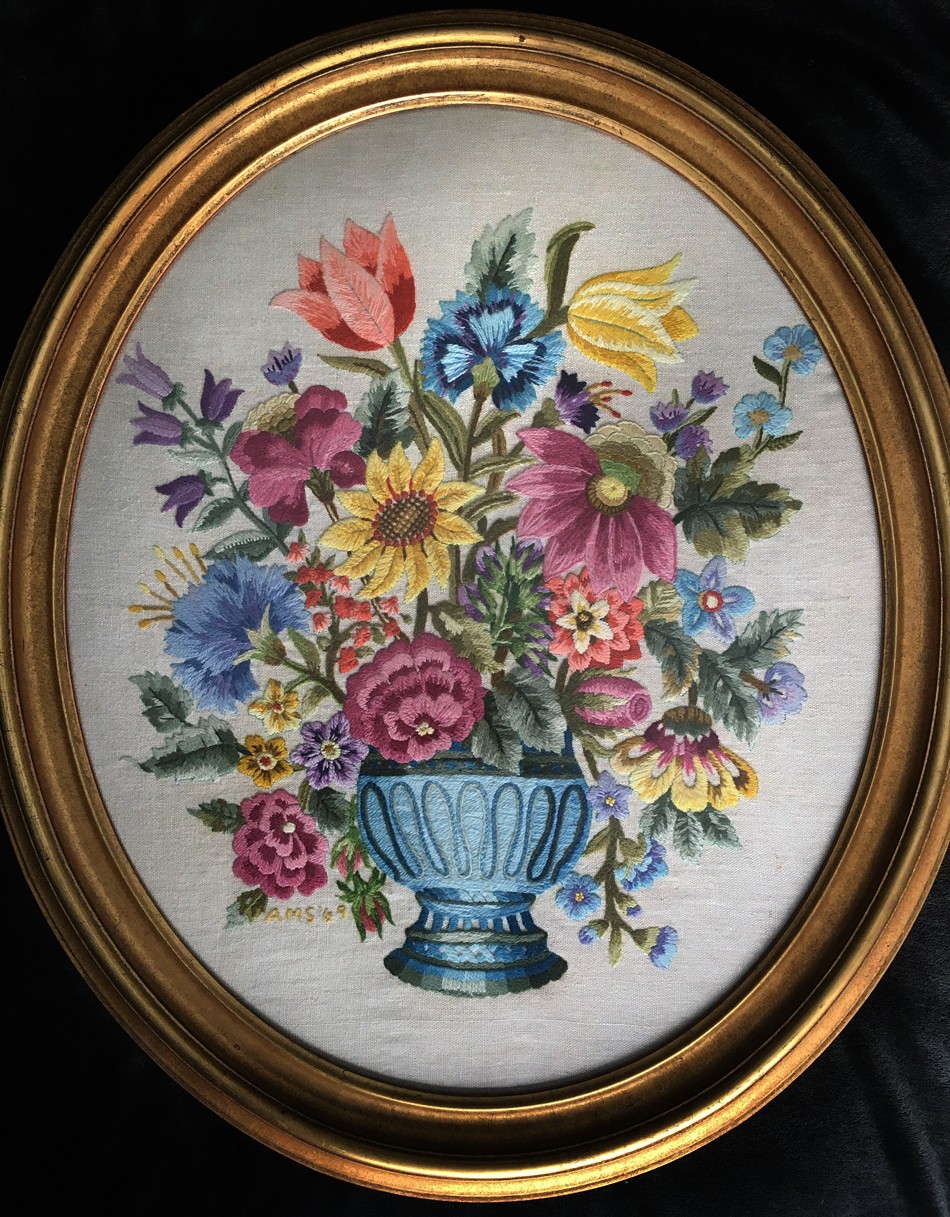
“Crewel Embroidery Flowers in Vase”: Ann McElroy Spencer, American: 1969: 28.25” x 24.25” : dyed wool thread stitched onto linen ground from pattern kit, framed in gilt oval wood frame. My mother learned to sew from her mother at a young age, making her own clothes and things for my brother and me. (Sometimes from the same pattern!) One of my earliest memories as a child was sometime in late 1967, when my mom took on this complex crewel work piece. I found a photo stating it took her 1 1/2 years to finish it, my young self intently following her needle as she worked on the orange and yellow tulips sprouting from the top of the bouquet. From: Authors family collection.
Shortly, we found ourselves in front of an unknown mailbox, in front of a house that was also unknown, at least to me. It was in the next moment, however, that she produced an envelope from somewhere, and proceeded to open the mailbox and deposit the letter within. I casually asked what she was doing and she matter-of-factly stated that earlier that spring, on a previous journey past this mailbox, she had made a mental note to bring along her camera in order to take pictures of flowers growing near it. “A very beautiful display,” or something to that effect, is my recollection of her intent, and reason enough to capture their beauty for eternity, thanks to photography’s magic. She had made prints and placed them in that envelope, intent on sharing them with whomever retrieved the mail at that address—folks that, to the best of my knowledge looking back these many years, were complete strangers. That was my mom. David Spencer-

“Ann and Charlie Spencer Reading by Battery & Candlelight”: Photograph by my wife Shannon O’Brien, 2012. During a power outage, my parents keep busy at the kitchen table of their Connecticut home in a favorite pursuit: reading. A long time public educator, one of my mom’s former students wrote this touching condolence: “Mrs Spencer was my 7th grade English teacher who inspired me to become a poet and the love of poetry. We were required to memorize selected poems which to this day I still can recite aloud. She was strict but kind. As a result of her love of the educational world, I also became a teacher of elementary students in Fairfield where we began each day with a poem to read and copy in script.” From: Authors family collection.
The Piano Lesson
by Ann Spencer
She was always there, waiting, just inside the door. I came lingeringly up the walk, book-bag bumping against my leg. She opened the door and I sidled past into the dim hall that seemed to smell of old things. “Five minutes late!” she said. I smiled weakly. I followed her into the living room, brushing against the heavy brown velveteen portieres, which helped keep the room warm in winter. She waited silently while I took off my coat and dropped it on the horsehair sofa. The armchairs, each with their antimacassars, stood guard, like sentinels, in their appointed places. Somewhere a clock chimed the quarter hour. It was risky to be late. It was rude to allow her to wait, in expectation, behind the etched glass window of the front door. Promptness was a virtue.
Ida Conrad Babb was Conservatory trained and was one of the two piano teachers in our small New England town. It was the depths of the Depression, and the money she made by giving lessons provided for her groceries: she had no car. She was tenacious of her pupils and held herself stiffly, as if the loss of even one student would cause her to crack and send her to the poor farm on East River Street. I recall her across the gulf of the years, not unkindly, but with some trepidation. She was one of the few adults in my life at the time who evaluated my work. I felt sorry for her- in my way. She was my first piano teacher.
We approached the piano which was housed in an alcove off the living room- a large instrument tucked into a little space, almost like an afterthought. Pulling out the music from my bag, I put Henri Hertz- Scales and Arpeggios on the piano rack. “Well,” she said, “let’s commence with the scales. We have to warm up the fingers first,” and she’d smile so that her slightly protruding teeth showed. I started off, thinking to myself that yesterday when I had practiced scales, I’d said to mother, “Henry Hertz when I do these!” and she had laughed. Now I dutifully sawed through the music- not much facility there- certainly no joy. I was sure she’d give me a “Fair” this week on my report card.
A dog barked somewhere in the back of the house, and I ploughed on through the other studies. “Mind your fingering.” “Commence again- play it at half-tempo.” And again: “You’re not practicing this étude as you ought,” she’d say, reproachfully. Never any praise. It was a relief when she said, “Get that folder, Ann, on top of the piano.” I moved carefully- not much space- and tentatively set aside the framed photograph of her brother killed in World War I. The street she lived on bore his name. I took the folder which contained the pieces. She leafed through the contents and selected one. Now I could sit in her seat by the window and she would sit at the piano and demonstrate how the piece should be played. Spare, erect, hand held above the keyboard- never would she allow them to droop- she played the short composition with fluidity and grace. “Your turn now, “ she said. She seemed happy to restore the piano to me. Never once did I hear her in recital.
After the lesson and after she had meticulously graded my report card- “Fair” for scales and arpeggios, “Very good” for the memorized piece- she told me to go to the kitchen- would I see the dog? to get a note for my parents which would be on the kitchen table. Entering the room, I was suddenly aware of her husband, smoking a pipe in the failing light of a winter’s afternoon. He knew my father, yet he spoke no greeting: a dusty plant, neglected, in a dark corner. I was a little afraid. “Hello,” I said, grabbed the note and didn’t wait for a response.
The tree at the end of her front walk still bore its leaves- sere, clicking against each other in the January wind. “That tree wun’t lose its leaves until spring,” she said. I stumbled back home across the frozen ruts of the two fields which separated our house from hers.
The following week, I commenced piano studies with the other teacher in town. He was a jolly man who emphasized popular tunes over études.